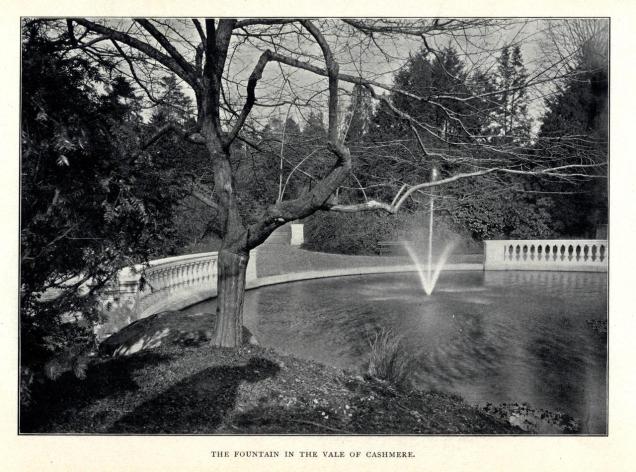In the knob and kettle terrain of Brooklyn’s Prospect Park, there is a natural valley sculpted by glaciers that was transformed by the park’s designers into a miniature Eden with reflecting pools and gardens.

It was named after a valley in Kashmir, the mountainous region straddling the India-Pakistan border. After decades of neglect, this section of Prospect Park is receiving renewed attention with a restoration project underway.
How it looked
In the 1904 postcard above from the Museum of the City of New York collection, a rounded pool is filled with plants, an apparent rococo landscape brought to life.

Fountains with lilies

Downhill from the Vale of Cashmere, the ravine has three round pools with fountains and lilies. Perhaps the star among them was the Victoria Regia, an Amazonian import. As the archival photo from the Prospect Park Alliance shows, it could hold a small child without sinking. By the look of this little girl, she was not so sure.
Poetic inspiration
The topography of the site made it ideal for a secluded there, where park goers can rest with little wind, and as much as the park set itself apart from the surrounding city, the Vale of Cashmere would serve as a park within the park. A report from 1918 by the American Scenic and Historic Preservation Society describes the layout of this site:

The amount of exotic flora in the Vale of Cashmere is notable as Brooklyn did not open its own botanical garden until 1911. The Vale received its name from romanticist poet Thomas Moore’s 1817 work Lalla-Rookh, a celebration of botany and romance in the Mughal imperial court. Here’s the full poem with an excerpt below.
The Vale of Kashmir is located at the juncture of the Himalaya, Karakoram, and Hindu Kush Mountains, a lengthy verdant plain along the Jhelum River. Regarded as a natural treasure by its historical rulers, it is home to distinguished Mughal gardens including Nishat Bagh, Chashme Shahi, Achabal, and Shalimar Bagh. The latter is the most famous of them, but shouldn’t be confused with the much larger Shalimars of Lahore or Delhi. The Victorian spelling of the region as Cashmere has since been standardized as Kashmir, with the exception of its famous wool, which is still today Cashmere.
Isolation and neglect
Seclusion for Prospect Park’s Vale of Cashmere can also mean isolation, neglect, and crime. On December 27, 1907, Brooklyn Heights resident Henry S. Terry shot himself here, despondent about his health, according to his father. By the 1960s, the former lily pools had run dry and were overgrown with weeds, as was the Vale of Cashmere. It reopened on September 19, 1969 amid criticism after Parks’ landscape architect Clara Coffey had removed the hemlocks, rhododendron and azaleas of this site. The fancy redesign needed constant care, something that Parks could not afford at the time.
Mayor John V. Lindsay spoke at the reopening as the fountains flowed. Soon after, the pipes had burst, the pools overflowed, and site’s three fountains have been dry ever since. No roses grow in the Rose Garden these days.
Illicit Activities
As with The Ramble in Central Park, this waterway’s discreet location made it an ideal spot not only for crime but also romantic trysts. Between 2008 and 2011, photographer Thomas Roma documented fashionably dressed mostly minority men at the Vale, looking for partners to satisfy their desires.
What’s there today
As the Vale of Cashmere awaits its restoration, for now it has the looks of an abandoned estate, left to natural forces. The photos below were taken by Parks Department inspectors in February 2016.
Where to find it
As the Vale of Cashmere isn’t the easiest thing to find in the park, here’s a map.
The three empty fountains of Rose Garden are marked by ovals, separated from the Vale of Cashmere by a thicket of trees.
In the news:
The Architect’s Newspaper reports on an interactive map of microorganisms that live in Gowanus Canal.
Untapped Cities has a story on fire alarm stations in the city’s parks, and another on pocket parks along Prospect Expressway.






5 thoughts on “Vale of Cashmere, Brooklyn”